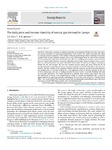Mostrar o rexistro simple do ítem
The daily price and income elasticity of natural gas demand in Europe
| dc.contributor.author | Erias Rodríguez, Antonio | |
| dc.contributor.author | Iglesias, Emma M. | |
| dc.date.accessioned | 2023-04-20T17:32:57Z | |
| dc.date.available | 2023-04-20T17:32:57Z | |
| dc.date.issued | 2022 | |
| dc.identifier.citation | Erias, A.F., Iglesias, E.M. (2022). The daily price and income elasticity of natural gas demand in Europe. Energy Reports, 8, 14595-14605. http://dx.doi.org/10.1016/j.egyr.2022.10.404 | es_ES |
| dc.identifier.issn | 2352-4847 | |
| dc.identifier.uri | http://hdl.handle.net/2183/32898 | |
| dc.description | Financiado para publicación en acceso aberto: Universidade da Coruña/CISUG | es_ES |
| dc.description.abstract | [Abstract] Data from 15 European countries is analysed to provide novel estimates of daily own-price, cross-price and income elasticities of natural-gas-demand from 2016 to 2020. The results show that: first, there is a strong-seasonal component in the October–February period during which residential-demand has a higher share on total demand, and gas price is not a determinant factor for most of the countries. This seasonal profile makes price-based tools more effective modifying end-consumer behaviours from March to August when estimated own-price elasticities present larger values in absolute terms. Second, there are estimated positive own-price elasticities from October to February in Bulgaria, Luxemburg, Poland, the UK, and Portugal. The first four countries present natural gas prices below the EU-28 average during the analysed period and it is argued that positive elasticities may reflect a disconnection between the price traded on the organized markets and the real price perceived by end-customers. For Portugal, who is currently carrying out a very aggressive policy to become coal-free by the end of 2021, natural gas and coal are mainly consumed in power sector to provide flexibility and back up renewable generation. The limited alternatives to provide these services may explain why coal and natural gas are found to be complementary. Finally, it is found that lockdowns due to covid-19 highly impacted on natural gas demand, confirming for the first time in the literature a “double heating effect”. Our results help to find when price-based tools by policymakers will influence more effectively natural-gas-demand following economic and environmental goals. | es_ES |
| dc.description.sponsorship | Ministerio de Ciencia e Innovación ; PGC2018-101327-B-100 | es_ES |
| dc.description.sponsorship | Xunta de Galicia ; ED431C 2020/26 | es_ES |
| dc.language.iso | eng | es_ES |
| dc.publisher | Elsevier | es_ES |
| dc.relation.uri | http://dx.doi.org/10.1016/j.egyr.2022.10.404 | es_ES |
| dc.rights | Atribución 4.0 Internacional | es_ES |
| dc.rights.uri | http://creativecommons.org/licenses/by/3.0/es/ | * |
| dc.subject | Natural gas | es_ES |
| dc.subject | Price elasticity | es_ES |
| dc.subject | Income elasticity | es_ES |
| dc.subject | Energy demand in Europe | es_ES |
| dc.subject | Double heating effect | es_ES |
| dc.title | The daily price and income elasticity of natural gas demand in Europe | es_ES |
| dc.type | info:eu-repo/semantics/article | es_ES |
| dc.rights.access | info:eu-repo/semantics/openAccess | es_ES |
| UDC.journalTitle | Energy Reports | es_ES |
| UDC.volume | 8 | es_ES |
| UDC.startPage | 14595 | es_ES |
| UDC.endPage | 14605 | es_ES |
Ficheiros no ítem
Este ítem aparece na(s) seguinte(s) colección(s)
-
GI-C+D - Artigos [115]






